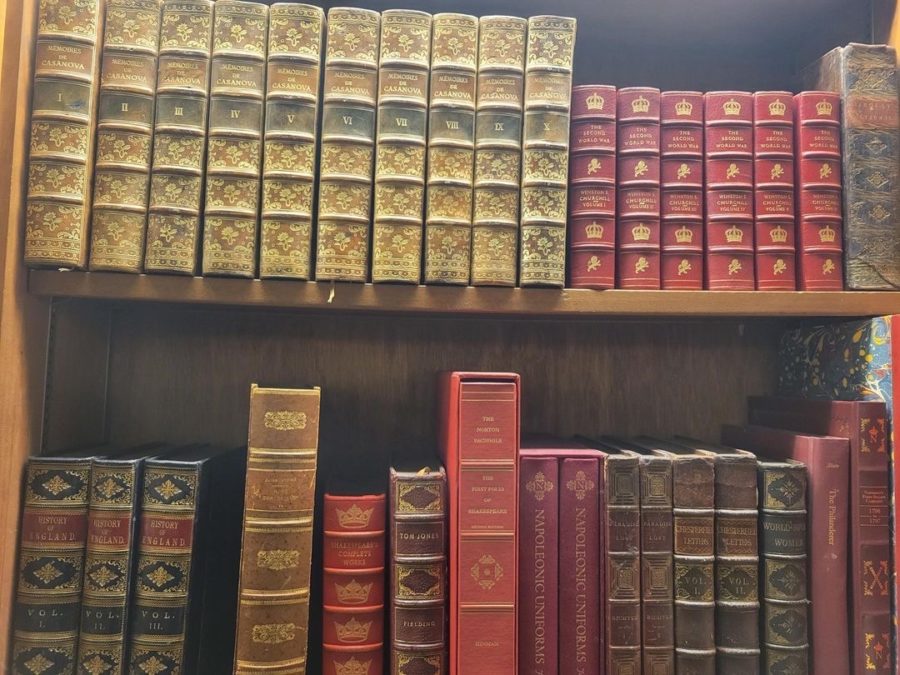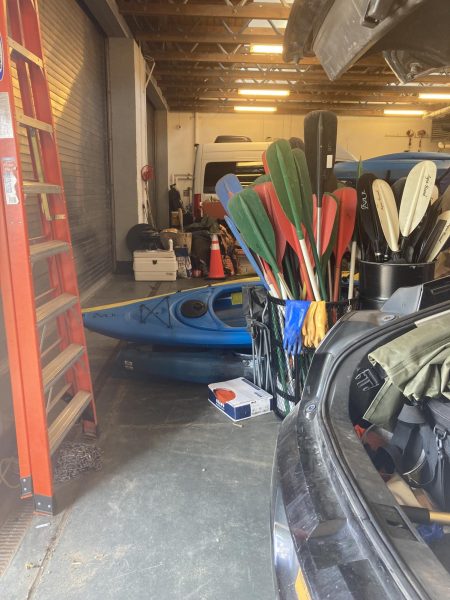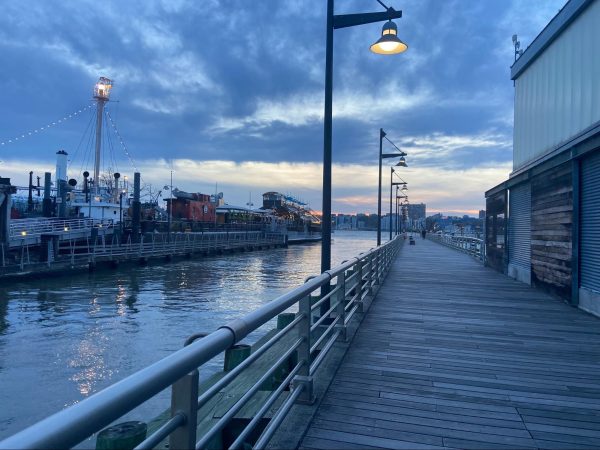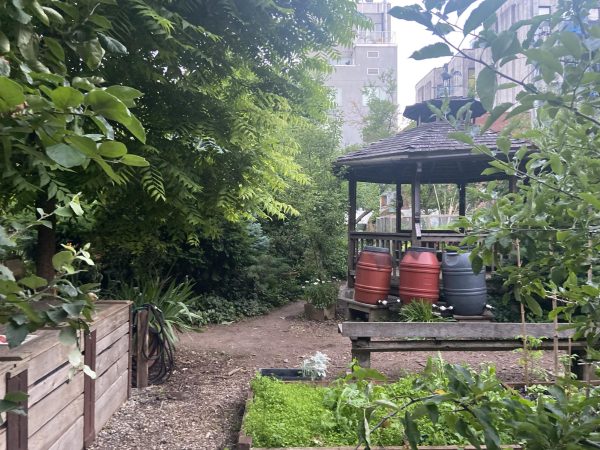A Tour of Independent Manhattan Bookstores and Why You Should Visit
In the fast-paced and hectic environment of New York City. the perfect place to grab some solace from the chaos are the city’s many bookstores
We all have experienced the New York City trek, a trip navigating from subway station to subway station, transferring many times along the way. On those lengthy trips, suspended in a metal carriage, underground and sheltered from the cell phone signal, the only thing one can do is pick up a book. Perhaps because one is forced to resort to books on the New York subway, the city itself offers the best in literature housed in some of the greatest bookstores in the world.
The Strand: History
The most famous of these locations is the Strand. The bookstore’s name derives from the Strand in London which has served as an epicenter for art’s proliferation for centuries. Among the famous inhabitants of the area are the modernist writer Virginia Woolf, the novelist Charles Dickens, and the Utilitarian philosopher John Stuart Mill.
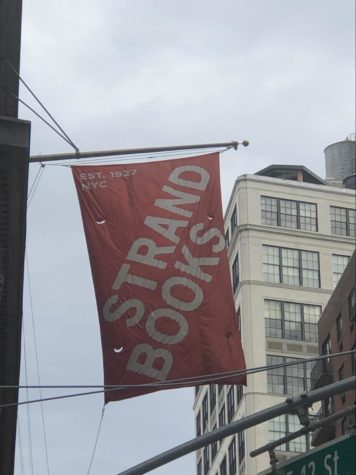
With this history in mind, Benjamin Bass, a Lithuanian immigrant, thought the name was perfect for his second bookstore, the first of which had failed. Thus, in 1927, the first iteration of the Strand was born on Book Row, a stretch of over 40 bookstores that all used to be located on Fourth Avenue in Manhattan.
Eventually, all of them were forced to shut down after massive rent hikes. However, the Strand survived due to the fact that they own their building and are spared rent hikes, consequently.
Another part of the reason the business has continued to stay afloat is because of the owners’ commitment to the entrepreneurial spirit. Learning from his father, Fred Bass spent decades — from 1957 when he inherited the business to his death in 2018 — scouring through private collections in order to acquire worthy inventory for the shop. Bass also made the move to establish the store’s location on 12th Street and Broadway in Manhattan.
After his death, Nancy Bass, Fred’s daughter, continued the tradition of entrepreneurship by making various efforts to modernize the store. In thinking about the appeals that a physical store might have in contrast to digital retail, Bass decided to emphasize the symbolic value of the store with slogans like ‘18 miles of books’ and a focus on the store’s logo.
New merchandise and memorabilia from tote bags to stickers and notebooks with the Strand’s logo plastered all over them were made available to purchase. The logo symbolizes sophistication, a connection to the authentic New York City experience, and a sense that one is cultured.
Yet, the Strand has much more to offer than this aspect of its atmosphere, as it offers one of the largest collections of books in a variety of genres, editions, rarities, and conditions. It is unrivaled by few other establishments in the sheer volume of books it has available to purchase and read. It boasts of being the largest used bookstore in the world, with over 2.5 million books in its collection.
The Strand: Upper Floors
The Strand is just a stroll away from the Union Square 14th Street subway station in Manhattan. There are a plethora of sights to see in and around Union Square, but the Strand is distinguished by a red banner waving in the air, sporting its iconic logo. Outside the Strand are stacks of low-priced used books — from old medical school textbooks to obscure children’s tales — and an assortment of plays and musical scripts.
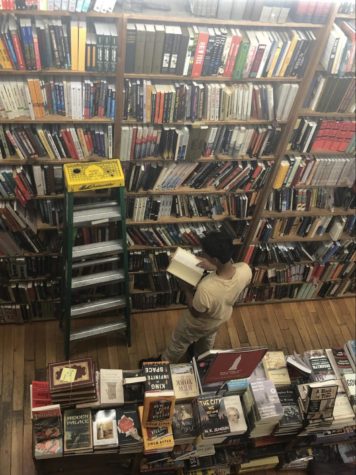
The store is comprised of three floors and a basement, with each one specializing in different genres. The main floor is where many of the most popular works of fiction are displayed on small tables scattered amongst the towering bookshelves, which find themselves concentrated near the back of the room. Its floors consist of wooden planks, tall white pillars extending to the upper floors appear around every corner, and fluorescent lamps festoon the ceiling.
One can find everything from Haruki Murakami’s modern classic Kafka on the Shore to James Joyce’s modernist avant-garde masterpiece Ulysses and contemporary works by Zadie Smith.
To the left of the entrance is the main register’s desk. Looking above it, you will be met with a visually pleasing assortment of multi-colored books arranged to resemble a rainbow. Towards the center of the first half of the room is a case of old leather-bound editions of classic works that look like they came straight out of the nineteenth century.
On the first floor, they keep books that fall into categories such as history, mystery & suspense, sci-fi & fantasy, and poetry. Between the bookshelves are different counters and kiosks where one can ask employees for the location of a specific work of writing, or even sell used books in good condition.
Though the entire collection is digitized and anything can be found with a few clicks, workers must have a familiarity with the collection in order to quickly navigate to a secluded corner of a shelf to retrieve a book, when necessary.
Moving onto the second floor, one can opt to take the stairs or the elevator. If you choose to take the stairs, on your way, you will find yourself on a small carpeted platform preceding the second floor containing literature and showcases on art. The names of the French impressionist Claude Monet, director of ‘The Shining’ Stanley Kubrick, and Studio Ghibli’s Hayao Miyazaki can all be found neatly arranged around each other.
The platform offers a sneak peek into the contents of the second floor which is structured similarly to the first. It places particular emphasis on art history, architecture, fashion, photography, and film.
The Strand: Basement
Taking the stairs down from the first floor, passing by hanging tote bags and an illustrated history of the store plastered onto the wall, you will reach the basement. From what you can see when you get down there, the basement used to be tiled in a baby blue but much of it has been removed to reveal a water-damaged gray concrete floor. The same pillars from the first floor appear here, trying to find their way among the various pipes and valves that characterize a typical basement.
The basement has an intimate and cozy ambiance, distinguishing itself from the loudness of the other floors. It is a lot more condensed and departs from the style of the rest of the building. At some points, it feels as though the shelves are closing in on you but in a comfortable way. Aside from that, many of the basement walls are covered with quirky imagery accompanied by book puns that add to the atmosphere.
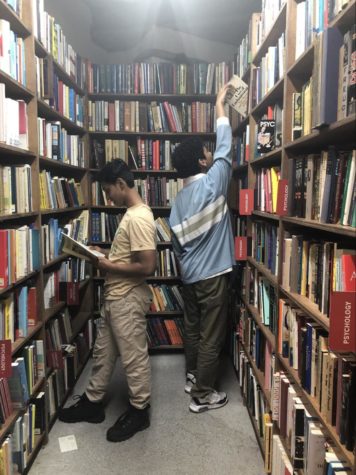
This floor places emphasis on academic works; there are books by university publishing houses, textbooks on law and psychology, works on mythology and folklore, and a vast array of philosophical literature.
For me, the basement is the crème de la crème of the store. Along with its atmosphere, it offers quite a decent selection of philosophy books which tend to be more elusive in bookstores, as they are more commonly bought online. Specifically, the Strand’s collection features a vast arrangement of continental philosophy.
What’s appealing about continental philosophers is that their work often intersects with political, social, and economic issues and seeks to change the world. Continental philosophers are also inextricably linked to each other; as it is a tradition of responding to and reinterpreting age-old arguments in light of new developments. So for any reader, it is a journey of making it through all of these thinkers and understanding their perspectives to develop one’s view.
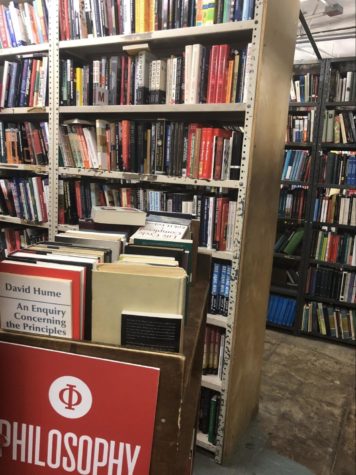
When I get to the Strand, I usually dart towards this section of the store. Friends have described my state when I go there as one of complete transformation. I will shift my body to be as horizontal as it can be to get a good look at the titles, authors, and even publishers of the books.
In front of the philosophy section is a table for the more popular works associated with the genre. Half of the books are a repetitive assortment of the same self-help book republished with a different cover, title, and author.
The other half includes landmark and foundational texts in the genre, such as philosopher Friedrich Nietzsche’s On the Genealogy of Morality which has had a profound influence on the field of epistemology, which is concerned with the nature and origins of knowledge.
The shelves are sorted in alphabetical order by the last name of the author. Philosophy is one of those genres of books where if one has read or looked enough, they can attain complete familiarity with all the authors in the section. From Adorno and Horkheimer to Deleuze and Guattari, there’s a whole cast of characters with whom to become acquainted.
When I go there, I will often see entire collections of the works of French social critic Michel Foucault and one full shelf of Slavoj Žižek. However, the Strand is always updating their collections, and every time I visit, I am sure to find a new book or edition of a classic work.
The Strand: Rare Books Room
The third floor is the most elusive of the three. If you try to access it by the stairs, you would be out of luck, as it is guarded by a red velvet rope signifying the prestige of the collection. This is the Strand’s rare books section, and it can only be accessed through the elevator.
Unlike the rest of the floors, the books here are enclosed in glass due to their higher monetary value. They range from special editions of works to limited run, out-of-stock books, and books autographed by their authors.
Currently, they have a collection of The Works of William Shakespeare selling for exactly $1,000. There are 20 volumes of these orange leather-bound books embossed with gold patterns and lettering on the spine. They are roughly one of 1,000 editions that feature a hand-colored frontispiece — a part of the books that features an illustration appearing after the title page — and is bound in Morocco leather, which is a type of goatskin that soaks in the dye of bright colors very well.
This floor is also utilized for special events, whether an author or an artist comes to sign or do an exclusive sampling of their works or an individual wants to rent it for a special occasion. The official Strand website states “ The Strand’s Rare Book Room is a perfect venue for weddings, celebrations, and private events. Spend your special evening surrounded by rare and antique books curated by Strand’s residential experts.”
Argosy Book Store
On the subject of rare books, one of the prime locations to find them is the Argosy Book Store located a couple of blocks from 59th street Station in Manhattan. The store stands out among its fellow concrete giants, having a rather simple design. It looks as though six blocks have been stacked upon each other to compose the building, yet despite this, the building emits a sense of refinement.
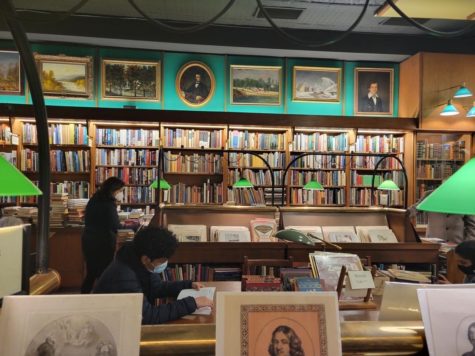
From the outside, one can observe that each of the windows on the floors has ‘Argosy Book Store’ written on them in gold lettering, except for the second floor. On the second floor is the store’s art gallery and its window reads ‘Argosy Gallery Early American Painters’ and in smaller letters and italics, ‘Fine Old Maps and Prints.’
Outside the store is a table of used books priced at three dollars, and most of them are art books. They cover a diverse array of art, with some books focus on studies of South Asian art, while others contain a compilation of vintage posters or a portfolio of the best art of a time period. Behind them are other used books, priced the same, with very good quality relative to their cost.
When you enter the store, you will notice an elevator to your left that will take you to the floors above. The elevator features an iron gate that folds in and out like an accordion, and it is operated by an elevator operator, a rare sight in today’s world of mostly automated elevators.Unlike modern elevators which save you from feeling the brunt of the sensation going up and down, the lurching of this elevator can be felt especially, as it slowly tries to establish a connection with the door of the floor.
This elevator and building became a part of the Argosy brand in 1964 after a series of migrations from its original location on the same Book Row that the Strand was located on. The store has been family-owned since its inception in 1925 and is currently in its third generation of ownership.
On the right side of the entrance is the main cash register counter with various bits of argosy-themed merchandise, from shirts to tote bags hanging in the wall behind it. The walls are painted a light teal green, which can mostly be seen near its top, due to the bookcases covering up most of it.
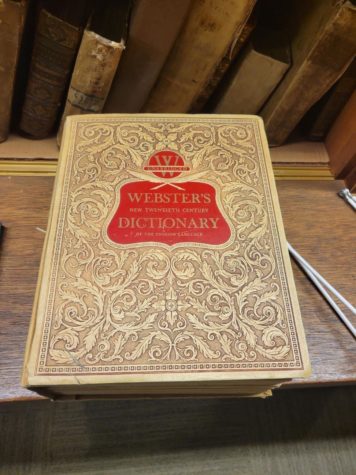
Despite resembling a library, the way it is decorated is quite maximalist. Aside from the bookshelves taking reign over the walls, there are various antique paintings hanging above them. Green lamps that are a couple of shades darker green compared to the walls dominate the room.
Next to shelves are staff desks with phones, laptops, computers, stacks of books and papers, and rolling office chairs.
In the middle, in between two small bookcases, is a wooden rectangular table and a couple of chairs that visitors can use to read any of the books they pick up off the shelves. Each side of the room is covered by one long stretch of bookcases. In the back is a small staircase leading up to an elevated platform with more bookcases and another one of the staff member’s desks.
Most of the books the store has to offer are old, out-of-print antiques in a plethora of different fields and genres. Some of the rarer books are kept in cases enclosed in glass, while others are freely spread among the edges of the bookcases. The store has been a place for many prestigious figures from Donatella Versace to Bill Clinton to add rarities to their personal collections.
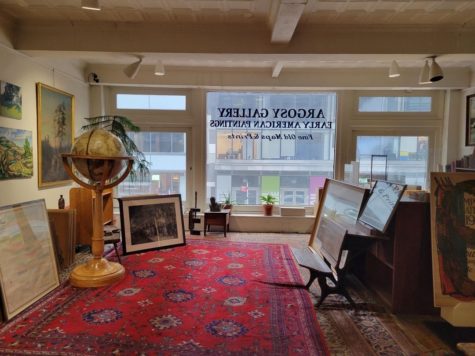
One particularly interesting book I found while scouring the shelves was an ornate edition of Webster’s New Twentieth Century Dictionary of the English Language. The cover was decorated in an intricate gold patterning of feathers, contrasted by a deep scarlet red in the middle of the pattern where the title was written in gold letters.
Along with these books, the store sells sheet music, vinyls, a variety of vintage prints, and old New Yorker magazine covers that can be used as posters, among other things. The whole building is basically like a book lover’s dream with five more floors full of their collection.
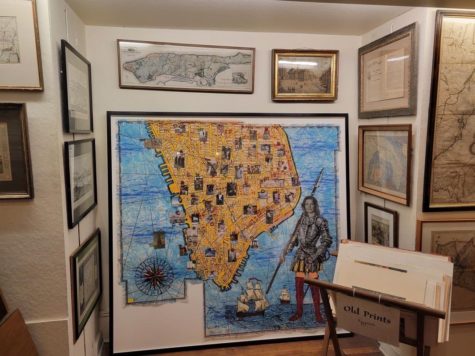
The second floor, as mentioned before, is the store’s art gallery which somehow condenses thousands of different art pieces into a relatively small space. On the first entrance, the thing that will catch your eye the most is a large globe that one can imagine was once a part of some rich and eccentric individual’s library in the 18th century.
Some of the bigger pieces of art are out on display while many of the other pieces are kept in labeled packages that you must ask the worker in the back of the room to look through. There’s a large painting displayed in one of the floor’s crevices that features an antique map of Manhattan with photos indicating its landmarks, and an illustration of a knight right next to it whose face has been replaced by the photo of a woman.
The walls of the rooms are filled to the brim with a number of different wall hangings, paintings, photographs, and even a bronze weathervane in the shape of an eagle. On the cabinets and storage spaces that direct the straight path that one takes through the floor are scattered smaller antiques. Illustrations of animals drawn onto cards that looked like they were used in early zoology books were placed next to vintage advertisements on flyers.
The rest of the floors hold the rest of the store’s collection, with books ranging in topics from medicine and science to World War II and magic tricks. Before leaving, one should take the time to appreciate the excellent view of the street from any of the upper floors.
East Village Books
There is something beautiful about a used book or used objects in general. At one point, I was addicted to purchasing second-hand books through eBay or thriftbooks. Besides the usual consumerist joy that comes with purchasing them, these books provide a unique connection that a pristine copy cannot.
The condition they come in could never rival their newer counterparts, but their tattered pages and folded covers only add to the appeal; they are the marks of the previous owner. What is the point of a book if it is not read? Do the stories and adventures etched into its pages disappear? One has only read a book when they have left their impression on it.
It could be as simple as a dog-eared page or as complex as a collection of passionate notes written into the margins. One feels that when they own a used book, they are continuing the work left by the previous owner and are creating their own interpretations from what remains.
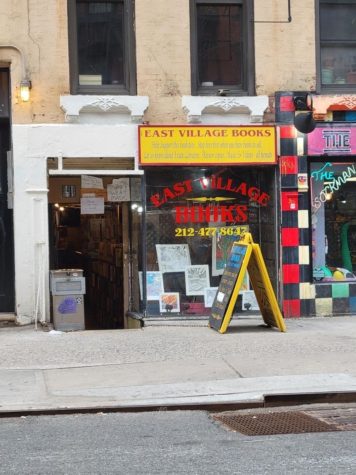
The perfect place to experience such a feeling is East Village’s own East Village Books located on Saint Mark’s Place and East 8th Street in Manhattan. As someone who has not spent much time in the East Village, I experienced a bit of a culture shock while navigating to the bookstore, asvit was unlike much of the rest of the city. People took as many risks as possible with their fashion, the storefronts had highly stylized designs, and one could find an Irish pub right next to a sushi joint.
However, the area is in a contradictory state at the moment. For many, it is known as the epitome of New York cool, rebellion, and grassroots actions which originates from its history as a breeding ground for punk rock. While some of these aspects remain, in recent years it has been under rampant gentrification which seeks to threaten everything it has stood for.
However, East Village Books is one of those locations remaining that embodies the spirit of the old Saint Mark’s Place. Greeting you outside is a signboard that is often used by restaurants to denote their menus and specials. This one reads ‘East Village Books’ in blue lettering and ‘Highest prices paid for Scholarly Libraries. Also Music & Videos-all formats, Prints Estate Specialist’ in yellow lettering below it. The store sign is yellow with a red border with similar wording to the signboard.
In the glass display is a rotating assortment of paintings and sculptures. As you enter the building, you will notice that it feels like one long corridor with some space for miscellaneous items on the side. It is quite cramped but that is because of the vast collection of items that are fitted into a relatively narrow space.
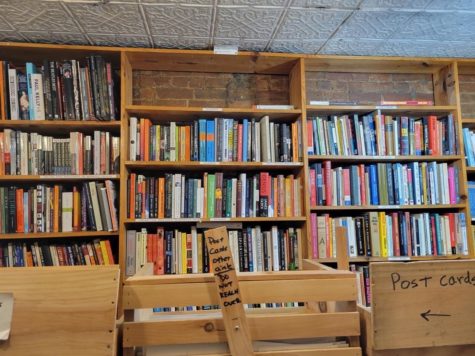
Near the back of the room, the path forks into two. While one leads to a dead end with some more bookcases, the other leads to the garden where more of the discounted used books are stored. As you open the door leading to it, you’ll unexpectedly drop down a foot and find yourself standing on a floor of rocks cornered by two bookcases. The ceiling material here transitions from tiled white roofing to green folded plates held up by wood beams.
I was drawn to the store because it specializes in used books as well as critical theory and continental philosophy. In comparison to the Strand’s collection, this one excels in rarity and obscurity. Some books that I had never heard of before or knew existed from my favorite philosophers were present on their shelves.
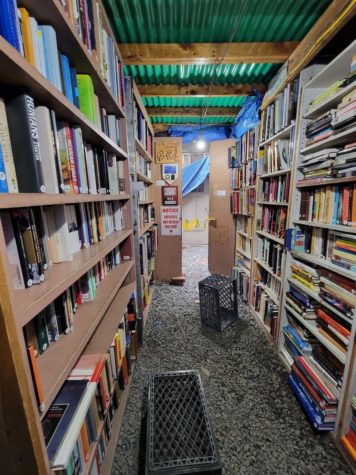
In terms of used books, the store offers many in excellent condition, priced from one to three dollars. In addition to the books, one can purchase CDs, DVDs, postcards, records, and prints among other things.
Even though the store is much smaller than some of its contemporaries, there is a treasure trove of niche tomes to be discovered. At this point in my journey looking through all these bookstores, I had spent most of my money, so I went to the used book section to pick something up at a smaller cost.
After trying to decide for some twenty minutes, I picked up a tattered copy of a research book on the Cuban revolution. It was nice to be able to shop in a small isolated place with a more carefully curated collection.
End
As I made my way home, I carried a green Argosy branded plastic bag filled with books from each store onto the train. I picked up each of my purchases from the day and flipped through the pages, and before I knew it I was getting off of the A train and walking the two blocks it took to get home.
Perhaps because one is forced to resort to books on the New York subway, the city itself offers the best in literature housed in some of the greatest bookstores in the world.
Rahib Taher is a Copy Chief for 'The Science Survey.' He enjoys journalistic writing as it gives him the liberty to write about topics that interest him....

